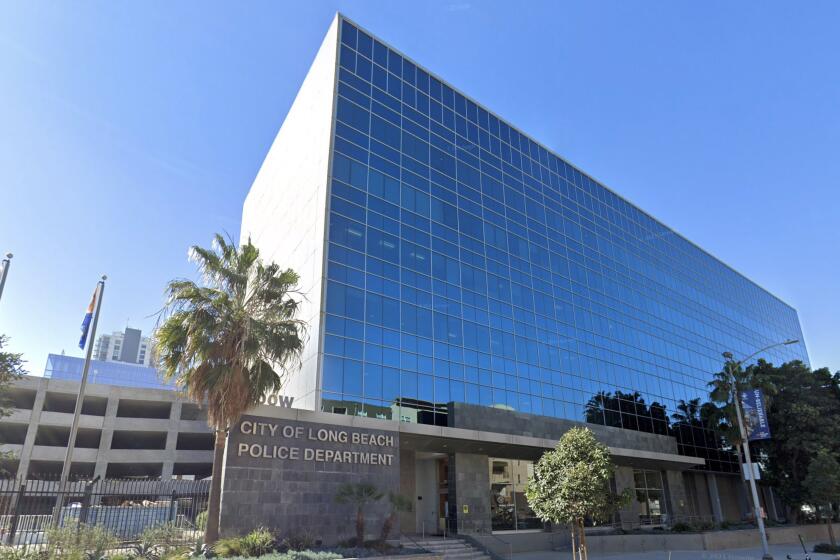Signing Off : Stiffer penalties, enhanced police activity and rewards have cut neighborhood graffiti. The fad is fading, officials say.
For the past decade, residents of southeast Los Angeles County have viewed the writing on their walls with increasing alarm. As graffiti crept in, entire neighborhoods were marked with the stamp of urban blight and it seemed no area was safe from the spiky calligraphy of taggers.
Tolerance ran out. Taggers were denounced, and laws were passed to keep spray paint out of teen-age hands and to force parents to pay for their children’s vandalism. Police officers were assigned to tagger investigation units, residents organized volunteer cleaning crews and cities invested thousands of dollars in cover-up paint. Some cities also offered rewards for information leading to the conviction of taggers. And convicted taggers began to pay a stiff price in court for their work.
Now, the news from the graffiti front may be better than expected. Aggressive anti-tagging efforts seem to be paying off.
In Long Beach, police officers estimate that tagging incidents are down by 90%. Graffiti paint-out crews are spending more time blending paint to fit the original wall color, less time slapping paint over fresh “tags.” In Norwalk, a special surveillance trailer, previously used to catch taggers in the act, has been sitting idle for six months, city officials said, because there are no problem areas to stake out.
Officials also say there hasn’t been a big jump in graffiti incidents this summer, when school vacations and idle hands in the past combined to create havoc with fresh paint.
“It’s just a fad, like break-dancing a few years ago, and it’s definitely on its way out,” said Alvin Bernstein, a Long Beach probation officer. “We can see the signs everywhere.”
In two middle schools, where Bernstein has offices during the school year as part of a gang-prevention program, fewer notebooks bear graffiti-style doodles, he said. There are fewer young taggers, Bernstein said.
Overall, police and city workers say, they are seeing cleaner walls and fewer organized tagging crews than they did about three years ago, when most believe the fad peaked.
Of course, this doesn’t mean the taggers have gone away. In one notorious incident recently, two competing crews covered seven miles of the Long Beach Freeway in both directions with paint, resulting in about $100,000 damage. So far, six adults and 10 juveniles have been arrested in connection with the spree.
Incidents like this keep the costs of fighting graffiti high, authorities say. The city of Long Beach, struggling through a lingering recession, spends about $1 million every year on a graffiti-abatement program that involves several departments, including police. That price tag has remained consistent for the past three years, said John Hough, special projects officer with the Public Service Bureau.
Even tiny La Habra Heights, which doesn’t have a single store or teen hangout within its city limits, spends $1,000 every year to paint over graffiti, mainly on street signs.
Homeowners and business people say there’s another cost--a decline in property values in areas coated with graffiti.
Many cities have assigned employees solely to clean up after teen tagging rivalries, and those salaries are generally dwarfed by the cost of paint and materials to cover up the tags. Even after a paint-out, buildings, alleys and schools can look as though they’ve suffered a bad case of blemishes. Paint colors don’t always match, multiple layers of paint begin to peel and a sense of urban blight sets in.
To combat this pox upon their houses, cities passed laws and funded programs to discourage taggers. Some offer hefty rewards for information that leads to the conviction of taggers. Many cities dictate that stores lock up spray paint, wide-tipped markers and glass-etching tools to keep them out of customers’ reach. The state also provided another weapon, a law prohibiting minors from possessing aerosol paint cans.
In Norwalk, the impact of the city’s anti-graffiti effort is most evident along the narrow one-way streets and old houses in the southwest part of town.
“It used to be that no sooner would you take graffiti off in the one-ways than it would be right back up,” said Kevin Gano, public safety director. “Now we don’t even see one-third the graffiti we used to.”
Gano says several programs, initiated by his city within the past four years, are responsible for the cleaner walls. The city offers free paint to residents to cover up graffiti, and responds within 24 hours to businesses requesting graffiti removal.
*
Norwalk officials also set up a surveillance team to stake out areas hard hit by graffiti. This Tagging Enforcement Suppression Team, known as TEST, consisted of sheriff’s deputies, probation officers, city workers and community volunteers who shared stakeout duties in a mobile trailer and waited for taggers to show up. In the past year, the trailer was deployed six times. The surveillance resulted in the arrest of about 20 taggers who were photographed or observed in the act, Gano said.
“The program has been so successful, we haven’t had to take the trailer out in about six months,” he said. “Graffiti is just way down.”
Gano says calls for graffiti removal have dropped from 5,989 in 1992 to 3,462 last year, to just 1,004 through July of this year. City spending on graffiti cleanup dropped from $268,000 in 1992 to $156,000 last year.
Gano said a city curfew for juveniles has also contributed significantly to the drop in graffiti. Seven days a week, between the hours of 10 p.m. and 5 a.m., sheriff’s deputies can pick up anyone under the age of 18 just for being outside without a guardian. Juvenile curfew violators are taken to a trailer, and parents are called to collect their children. While not all of the late-night teens are taggers, just getting kids off the streets at night has helped reduce graffiti, Gano said.
*
If there is a second curfew violation, parents are charged $163 to help defray costs of deploying the trailers, and must appear before a Juvenile Court commissioner, where they could be fined an additional $100 and be sentenced to 60 hours of community service, generally cleaning graffiti. The commissioner can also require Mom and Dad to attend parenting classes.
Long Beach also has a curfew, but no ordinance to penalize parents of repeat violators. Council members are considering such a law.
Some school districts are also taking advantage of a 2-year-old state law giving school officials the authority to make parents financially responsible for the crimes of their children on school property.
The Downey Unified School District bills parents of children caught vandalizing school property. The Norwalk-La Mirada Unified School District is considering a similar plan.
Although painting out walls and fining parents help reduce graffiti, police officers say a brush with the law and the threat of harsh penalties can really persuade taggers to give up their aerosol cans.
Two staunch advocates of aggressive penalties for taggers are Long Beach police officers Bob and Barry Fowks. For two years, the brothers have spent much of their time on tagging investigations. They pride themselves on knowing most of the paint-flecked players in town.
Leaning against a pale blue sedan they consider their office, Barry Fowks pulls two pictures from a thick stack of Polaroids showing Long Beach taggers and their handiwork. The Fowkses have been watching two brothers, waiting patiently for the right time to make an arrest.
*
“See, if we just let them go a little, we’ll have enough evidence to convict them of felony vandalism. We’ve given them some rope and they’re getting close to hanging themselves,” said Barry Fowks, 41.
Once graffiti damage tops $5,000 a juvenile or adult can be charged with a felony.
Once a tagger is convicted, the punishment can make tagging seem very unattractive.
Juvenile Court Commissioner Robert Axel knows how to get a teen-ager’s attention, Fowks said. Although there are variations, Axel generally imposes the following restrictions on convicted taggers:
* Attend every class every school day, no exceptions without a signed doctor’s note.
* Maintain a C average.
* Be home by 8 p.m., seven days a week, for a year.
* Give up driver’s license until age 21.
* Pay restitution for graffiti damages.
* Perform 100 hours of community service, painting out graffiti under supervision of parents.
If the youths get caught staying out late or driving a car--necessary privileges to carry out all-important teen dating rituals--they could be sent away to juvenile camp for six months. Teen-agers convicted of a felony could be locked up for three years for violating probation.
“I’ve tried a number of things over the years, from locking them up to begging and pleading,” Axel said. “This seems to work.”
In Norwalk courtrooms, a typical punishment might be loss of a driver’s license for one year, restitution for damages, fines and community service ranging from 60 hours to 20 days, authorities said.
The Fowks brothers and probation officer Bernstein agree that Axel’s sentences seem to work. Youths who have heard of the punishment have approached the Fowkses and Bernstein, swearing they’ve left their tagging days behind.
“The probation (conditions) he hands out really would have hurt when I was that age,” Bob Fowks said.
*
The Fowkses estimate that tagging incidents have dropped by 90% in the past two years.
“We drive the 50 square miles of Long Beach every day we work. We know when new tags go up and where,” said Bob Fowks, 51. “And we’ve seen a huge drop in activity.”
They give a tour of a Central Long Beach neighborhood whose buildings bear familiar patchwork paint jobs, but very few new tags.
Some taggers say pressure from an unlikely source--gangs--has also contributed to the decline of graffiti.
“Back in ‘91, it was really fun,” said Paul Afa, 17. “Everybody thought it was cool. But in ‘93, the (Mexican) Mafia came in and told the gangs to make the taggers calm down. Then it got dangerous.”
Afa’s crew broke up, he said, after several were arrested and others were intimidated by gang members who flashed guns and made threats.
Bernstein, the Fowks brothers and others said they also had heard that organized gangs were threatening taggers. The gang members didn’t like the taggers bringing law enforcement heat into the neighborhoods, interfering with more serious criminal activity.
As if the gang members, police, teachers, probation officers and tough judges weren’t enough, taggers also faced another foe--self-appointed graffiti busters. Known derisively as “heroes,” these people cruise the area searching for taggers, taking pictures and noting license-plate numbers, and turning them in to authorities to collect rewards.
One such hero, a former Long Beach resident who asked not to be identified for fear of reprisal, has made about $20,000 in recent years by collecting reward money, mostly from Long Beach, which offers $1,000 per conviction. He is well-known to police for his frequent tips.
But there’s a downside to this kind of work. After living 30 years in Long Beach, he moved his family to Compton two years ago, where fewer people knew his sideline. He also dons a bulletproof vest before cruising for taggers.
“Now they have tag-bangers, these kids who are in the initiation process and about to join a gang, and they’re more violent,” he said.
*
Afa was headed down this path, but was caught, convicted and received one of Axel’s stiff sentences. Afa says he has sworn off tagging entirely.
Around his Central Long Beach neighborhood, he says he still sees a few younger wanna-be taggers, and they just make him shake his head and laugh.
“One day, those younger kids will find out the hard way, just like I did,” Afa said. “And when they do, they’ll stop tagging, too.”
More to Read
Start your day right
Sign up for Essential California for news, features and recommendations from the L.A. Times and beyond in your inbox six days a week.
You may occasionally receive promotional content from the Los Angeles Times.






